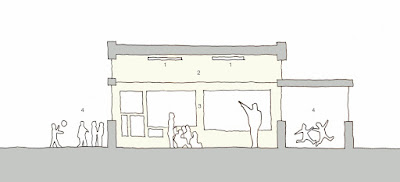A quiet look at how sound shapes the way we learn, teach, and feel in schools.
 |
| Considering acoustic treatment: 1 Acoustic ceiling panels 2 High level acoustic wall panels 3 Cork and felt lined display boards 4 Sound proofing from outside activities |
The Spaces That Talk Back at Us
We all know the rooms.
The ones where the noise just… hangs.
Where staff raise their voices without realising.
Where concentration dips by mid-morning—and tension quietly rises.
Sometimes, it’s not the behaviour that’s the issue.
It’s the acoustics.
Why Sound Matters More Than We Think
Sound affects more than hearing.
It affects attention, memory, regulation, and physical stress levels.
In schools—especially busy urban ones—acoustic quality can change the whole tempo of the day.
For staff:
Constant background noise increases cognitive load
Voice strain is common (and exhausting)
Poor acoustics make behaviour management harder than it needs to be
For students:
Processing language in a reverberant room can increase anxiety and reduce engagement
For neurodiverse learners, the impact can be overwhelming
The Department for Education sets minimum standards in BB93.
But many buildings, especially older ones don’t meet them—and often refurbishments don’t prioritise them.
And yet the difference can be felt within days of making changes.
According to Sharon Baker, an acoustics expert at Ecophon:
A standard classroom might have a reverberation time of 1.2 seconds—resulting in echo and elevated ambient noise.
Teachers may need to speak over the background, which can strain vocal cords and cause long-term issues.
Classrooms with ceilings higher than 2.8m are more prone to echo.
If the back row of desks is more than 9m from the teacher, speech intelligibility drops dramatically.
Noise from corridors, playgrounds or adjacent rooms can interfere with focus unless sound insulation is considered.
For pupils with hearing loss, visual impairments, autism, ADHD or EAL needs, greater sound absorption is essential. A reverberation time of 0.4 seconds is typically recommended.
What Can Be Done (Without a Major Overhaul)
This isn’t about spending a fortune or gutting classrooms.
It’s about small interventions, well placed.
Some practical strategies we’ve seen work well:
Acoustic ceiling panels in high-ceiling classrooms to reduce echo without compromising sense of space
High-level wall panels on front or rear walls, where display space isn't needed
Swapping hard surfaces for soft ones: felt-lined cork display boards, carpet and underlay, beanbags or soft furnishings in reading corners
Soundproofing from outside sources where necessary
Rethinking zoning: avoid placing quiet workrooms next to echoey corridors
Designing in sound absorption, not just adding furniture
These aren’t just tricks. They’re thoughtful responses to how people experience sound.
Acoustic performance can even be assessed using a smartphone decibel app. If the classroom regularly peaks above 65dB during lessons, it may benefit from acoustic treatment.
Typical costs for acoustic interventions range between £2,500 to £3,500 + VAT, adjusted for inflation from 2013 estimates.
Listening is Part of Design
At DesignBox, we don’t come in with fixed answers.
We listen—to your staff, your students, your site.
Sometimes what’s needed is a tweak. Sometimes it’s a sequence of improvements, phased over time.
But always, the goal is the same: to make the space work with your school—not against it.
Want to Explore This in Your Context?
If there’s a space in your school that feels “off” acoustically—and you’re not sure where to start—feel free to get in touch.
Book an enquiry call
We’ll ask a few questions, listen carefully, and help you think through what’s possible.
No pressure. No jargon. Just thoughtful support.
Thanks
Phil
DesignBox Architecture Ltd
Listening with design—so schools can flourish.








